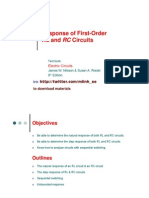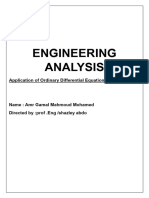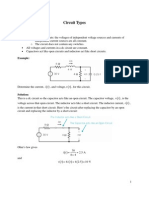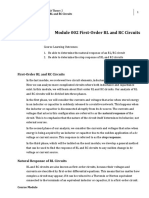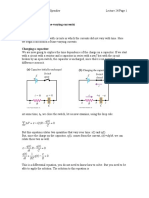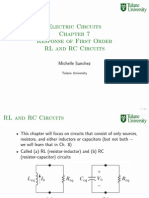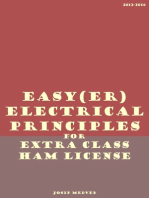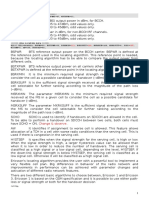Lec7 FirstOrder
Uploaded by
Khanh NamLec7 FirstOrder
Uploaded by
Khanh NamFundamentals of
Electrical Engineering
Electronic & Telecommunication Engineering
Danang University of Technology
Lecture 7
Response of First-Order
RL & RC Circuits
(chapter 7)
Preview
Be able to determine the natural response of both RL
& RC circuits
Be able to determine the step response of both RL &
RC circuits
Know how to analyze circuits with sequential switching
Be able to analyze op-amp circuits containing resistors
& a single capacitor
Problem & Methodology
Recall: both inductors and capacitors can store energy
How to determine the i(t) and v(t) that arise when energy is
either released or acquired by an L or a C in response to
an abrupt in a DC voltage or current source ?
Analysis on RL & RC circuits will be carried out in 3 phases:
Natural response: i(t) & v(t) that arise when stored energy
in L or C is suddenly released to a resistive network
Step response: i(t) & v(t) that arise when energy is being
acquired by L or C due to the sudden application of a DC
voltage or current source
Develop a general method that can be used to find the
response of RL & RC circuits to any abrupt changes
Def: circuit whose voltages and currents are described by
first-order differential equations.
Examples:
RL circuits: only sources, resistors (R), inductors (L)
RC circuits: only sources, resistors (R), capacitors (C)
RLC? chapter 8
First-order circuit
General Configurations
Natural Response of RL Circuit
Suppose the switch has been closed before t = 0 for a
long time, i.e., all currents and voltages had reached a
constant value (steady-state).
When the switch is opened at t = 0 we are interested in
the natural response of the RL circuit from t = 0.
Note that there is a discontinuity at t = 0. For example, the
current through the switch is I
s
for t < 0, and 0 for t > 0.
Often, we write in short i
s
(0
) = I
s
and i
s
(0
+
) = 0.
After opening the switch, we can simplify the circuit as
another circuit depicted on the left side
Now we want to find i(t) and v(t):
- Apply KVL: Ldi/dt + Ri = 0
- Ordinary first-order differential equation with constant
coefficients
Natural Response of RL Circuit
Solving
Initial condition
Define i(0) ?
We knew that i
L
(0
) = I
S
(current through inductor)
We also know that inductors do not allow instantaneous
changes in current. Therefore,
i
L
(0
+
) = i
L
(0
) = I
s
i(0) = I
s
= I
0
So, the natural response of the RL circuit is:
(since v(0
-
) <> v(0
+
), the voltage v(t) is
defined only for t > 0 )
Example
v(0
-
) <> v(0
+
)
Power & Energy
Significance of Time Constant
i(t) = I
0
e
R/Lt
is the natural response of RL circuit.
R/L determines the rate at which the current or voltage
approaches zero.
If R is big, then fast decay (energy dissipates more
quickly).
If L is big, then slow decay (L opposes change in
current, and a big inductor stores more energy).
Define Time Constant , thus
R L/ = t
Significance of Time Constant
One time constant after the inductor has begun to release its
stored energy to the resistor, the current has been reduced to
e
1
, or approximately 0.37 of its final value.
After 5 , the current is less than 1% of its initial value, which
practically reached their final value.
Thus, the existence of the current I
0
in the RL circuit above is a
momentary event and referred to as the transient response of
the circuit.
Consider the tangent of natural response at t = 0:
Now, if i(t) starts as I
0
and decreases at a constant rate,
the expression for i(t) becomes:
This leads to a simple way to measure time constant (fig.)
t /
0
) (
t
e I t i
=
t I I i ) / (
0 0
t =
Significance of Time Constant
Example
After a long time of closing, the switch is opened at t=0. Find
a. i
L
(t) for t 0
b. i
0
(t) for t 0
+
c. v
0
(t) for t 0
+
d. Percentage of total energy stored in the 2H inductor that is
dissipated in the 10 resistor
Example
The initial currents in inductors L
1
& L
2
have been established
by sources not shown. After opening the switch at t=0,
a. Find i
1
& i
2
and i
3
for t 0
b. Calculate the initial energy stored in the parallel inductors
c. Determine how much energy is stored in the inductors as t
infinity
d. Show that the total energy delivered to the resistive network
equals difference between the results obtained from b. & c.
*
**
Assessment Problem
a. Calculate the initial value of i(t)
b. Calculate the initial energy stored in the inductor
c. What is the time constant of the circuit for t > 0
d. What is the numerical expression for i(t) for t 0
e. What percentage of the initial energy stored has been
dissipated in the 2 resistor 5ms after the switch has
been opened?
Natural Response of RC Circuit
The analysis is very similar to the RL circuit.
At t = 0
& t = 0
+
circuit can be simplified as shown above
We want to find v(t) and i(t). KVL: C dv/dt + v/R = 0.
Power and Energy
First-order circuits
Circuits with one capacitor or one inductor are called first
order circuits, because they give rise to first order linear
differential equations.
Engineers have a love/hate relationship with differential
equations. They describe the things we do engineering with,
like circuits, so we need to understand them and obtain
solutions. But we are not math majors! All we want is a
solution! We don't care that there are eight different ways to
solve a differential equation, we just want one way that works!
So what we'll do with first order circuits is first write the circuit
equations from the circuit. Then we'll solve them formally, just
once to prove we can do it. Then we'll develop a short cut so
that all we have to do is write the form of the solution and fill in
some numbers from looking at the circuit. And that's the
method you really use to solve first order circuits.
Example
After a long time in position x, the switch is
a) Find the value of R that enables the shown circuit to
deliver the maximum power to the terminals a & b
b) Calculate the maximum power transferred to R
Step Response for RC Circuit
Let's start by considering the circuit before t = 0. There is
clearly no current, but what about capacitor voltage?
Well, it could be anything, really, in this case, so the
problem has to specify this initial condition.
Let v(0
-
) = 0. Time just before t = 0 is denoted as t = 0
-
Now consider the circuit at instant after the switch
closes. (this would be t =0
+
).
Recall that: i(t) = C dv/dt
No time goes by from 0
-
to 0
+
, so any change in voltage
across the capacitor would require infinite current, which
is not possible. Therefore, capacitors cannot change
voltage instantaneously.
v(0
-
) = v(0
+
)
Step Response for RC Circuit
This means all the source voltage appears across the
resistor (by KVL). Then the current is
So the current did change instantaneously through the
capacitor. We could calculate the rate of change of
capacitor voltage as:
Step Response for RC Circuit
Apply KCL at the capacitor
Step Response for RC Circuit
We can find the value of B from considering the initial
condition
We can check this by considering what happens as t
goes to infinity. In steady state, with a constant source,
we expect the capacitor current to go to zero.
Recall:
Step Response for RC Circuit
General solution
ANY circuit with one capacitor and a resistor has a
solution of the form
( )
RC t
RC t
Be A t v
e v v v t v
/
/
) (
) ( ) 0 ( ) ( ) (
+
+ =
+ =
Calculating Procedure
1. Find the initial condition, v(0
+
), from v(0
-
).
2. Find the steady state solution, v(), using the fact that
the capacitor is an open circuit at t =
3. Find the value of RC. (This value is so useful it has a
special name, time constant)
4. Write the solution:
5. Plug the two voltage values into the solution to find A
and B. Use v() first!
6. Make sure you answered the question being asked!
RC t
Be A t v
/
) (
+ =
Example
Given v(0
-
) = 0V, Find i(t) for 0 < t <
Step Response for RL Circuit
Now let's look at a circuit with an inductor instead of a
capacitor. We'll start with the simplest possible circuit
When the initial energy in the inductor is zero:
L tR
s s
e
R
V
I
R
V
t i
/
0
) (
|
.
|
\
|
+ =
L tR
s s
e
R
V
R
V
t i
/
) (
|
.
|
\
|
+ =
Review of General Solution
Sequential Switching
More than one switching operation in sequence.
Time reference for all switchings can not be t = 0
Approach:
Treat each switching as a separate step response.
Derive v(t) & i(t) for a given position of switch or
switches and then use these solutions to determine the
initial conditions for the next switch positions
Remember that inductive currents and capacitive
voltages cannot change instantaneously
Example
Integrating Amplifier
For an ideal op amp, i
f
+ i
s
= 0 and v
n
= v
p
.
v
p
= 0, so i
s
= v
s
/R
s
and i
f
= C
f
dv
o
/dt
Thus dv
o
/dt = i
f
/C
f
= v
s
/R
s
C
f
Solution
Integrating Amplifier
In particular, if t
0
= 0 and at t
0
there is no energy stored
in C
f
:
Output v
o
(t) is the integral of the input signal, scaled by
-1/R
s
C
f
Unbounded Response
In particular, if t
0
= 0 and at t
0
there is no energy stored
in C
f
:
Output v
o
(t) is the integral of the input signal, scaled by
-1/R
s
C
f
Example
After a long time in position x, the switch is
a) Find the value of R that enables the shown circuit to
deliver the maximum power to the terminals a & b
b) Calculate the maximum power transferred to R
Abstable multivibrator
Monostable multivibrator
You might also like
- Lecture 01 - Response of First-Order RL and RC Circuits - MLinhNo ratings yetLecture 01 - Response of First-Order RL and RC Circuits - MLinh40 pages
- Unit 3 - Network Analysis - www.rgpvnotes.inNo ratings yetUnit 3 - Network Analysis - www.rgpvnotes.in19 pages
- Capacitor and Inductor Transient Response: ECE 270 Lab #4 Capacitors and InductorsNo ratings yetCapacitor and Inductor Transient Response: ECE 270 Lab #4 Capacitors and Inductors14 pages
- First-Order Circuits: An Independent Source. Thus, The Elements of ANo ratings yetFirst-Order Circuits: An Independent Source. Thus, The Elements of A9 pages
- Module 002 First-Order RL and RC CircuitsNo ratings yetModule 002 First-Order RL and RC Circuits11 pages
- ELECTRICAL CIRCUIT ANALYSIS-DIGITAL NOTES (1) - CompressedNo ratings yetELECTRICAL CIRCUIT ANALYSIS-DIGITAL NOTES (1) - Compressed7 pages
- UNIT-1: Lecture Notes Unit 1: Transient AnalysisNo ratings yetUNIT-1: Lecture Notes Unit 1: Transient Analysis36 pages
- RC Circuit Response Introduction & TheoryNo ratings yetRC Circuit Response Introduction & Theory6 pages
- Analyze An RLC Circuit Using Laplace Methods - Dummies - 1589011872183No ratings yetAnalyze An RLC Circuit Using Laplace Methods - Dummies - 15890118721835 pages
- Electric Circuits Response of First Order RL and RC Circuits0% (1)Electric Circuits Response of First Order RL and RC Circuits56 pages
- Time Domain Response of First Order RL and RC Circuits100% (1)Time Domain Response of First Order RL and RC Circuits21 pages
- Easy(er) Electrical Principles for Extra Class Ham License (2012-2016)From EverandEasy(er) Electrical Principles for Extra Class Ham License (2012-2016)No ratings yet
- KEY WORDS: Athletes, Preparatory Activities, Maximum Dynamic StrengthNo ratings yetKEY WORDS: Athletes, Preparatory Activities, Maximum Dynamic Strength1 page
- Adaptive Systems - Problem Class 5: The Leaky LMS AlgorithmNo ratings yetAdaptive Systems - Problem Class 5: The Leaky LMS Algorithm2 pages
- Adaptive Systems - Problem Class 4: The LMS AlgorithmNo ratings yetAdaptive Systems - Problem Class 4: The LMS Algorithm2 pages
- Chapter4 (2W) - Signal Modeling - Statistical Digital Signal Processing and ModelingNo ratings yetChapter4 (2W) - Signal Modeling - Statistical Digital Signal Processing and Modeling137 pages
- Favorever Bluetooth Speaker Catalog With Price To Sho20170303No ratings yetFavorever Bluetooth Speaker Catalog With Price To Sho2017030382 pages
- How Sms Language Effect Writing Skills of StudentsNo ratings yetHow Sms Language Effect Writing Skills of Students7 pages
- Principles of The WCDMA System: InternalNo ratings yetPrinciples of The WCDMA System: Internal46 pages
- Mcset 1-2-3: MV Distribution Factory Built Assemblies at Your Service AnglaisNo ratings yetMcset 1-2-3: MV Distribution Factory Built Assemblies at Your Service Anglais26 pages
- Lf353 (Lm353, Ka353) Dual Operational Amplifier (Jfet)No ratings yetLf353 (Lm353, Ka353) Dual Operational Amplifier (Jfet)3 pages
- DVD Receiver Sony Hbd-tz135 Dav-Tz135 v.1.1100% (1)DVD Receiver Sony Hbd-tz135 Dav-Tz135 v.1.128 pages
- Lesson Plan-Communication System Unit No. Planned Date Hr. NoNo ratings yetLesson Plan-Communication System Unit No. Planned Date Hr. No9 pages
- A Designers Guide To Instrumentation Amplifiers 3rd EdNo ratings yetA Designers Guide To Instrumentation Amplifiers 3rd Ed130 pages
- Frequency To Voltage Converter Circuit DiagramNo ratings yetFrequency To Voltage Converter Circuit Diagram8 pages
- White Paper: Optical-Based Analog Front End For Low - Speed Powerline Communications in The HomeNo ratings yetWhite Paper: Optical-Based Analog Front End For Low - Speed Powerline Communications in The Home5 pages
- 713 - No 30 Every Child Should Have A Mobile Phone (Junior)No ratings yet713 - No 30 Every Child Should Have A Mobile Phone (Junior)4 pages
- 7) MTH-75-R-WP - Out Door Multi Candella Sounder StrobeNo ratings yet7) MTH-75-R-WP - Out Door Multi Candella Sounder Strobe5 pages
- Performance of Turbo Encoder and Turbo Decoder For LTE: ISSN: 2277-3754No ratings yetPerformance of Turbo Encoder and Turbo Decoder For LTE: ISSN: 2277-37544 pages
- Lecture 01 - Response of First-Order RL and RC Circuits - MLinhLecture 01 - Response of First-Order RL and RC Circuits - MLinh
- Capacitor and Inductor Transient Response: ECE 270 Lab #4 Capacitors and InductorsCapacitor and Inductor Transient Response: ECE 270 Lab #4 Capacitors and Inductors
- First-Order Circuits: An Independent Source. Thus, The Elements of AFirst-Order Circuits: An Independent Source. Thus, The Elements of A
- ELECTRICAL CIRCUIT ANALYSIS-DIGITAL NOTES (1) - CompressedELECTRICAL CIRCUIT ANALYSIS-DIGITAL NOTES (1) - Compressed
- Analyze An RLC Circuit Using Laplace Methods - Dummies - 1589011872183Analyze An RLC Circuit Using Laplace Methods - Dummies - 1589011872183
- Electric Circuits Response of First Order RL and RC CircuitsElectric Circuits Response of First Order RL and RC Circuits
- Time Domain Response of First Order RL and RC CircuitsTime Domain Response of First Order RL and RC Circuits
- Easy(er) Electrical Principles for Extra Class Ham License (2012-2016)From EverandEasy(er) Electrical Principles for Extra Class Ham License (2012-2016)
- KEY WORDS: Athletes, Preparatory Activities, Maximum Dynamic StrengthKEY WORDS: Athletes, Preparatory Activities, Maximum Dynamic Strength
- Adaptive Systems - Problem Class 5: The Leaky LMS AlgorithmAdaptive Systems - Problem Class 5: The Leaky LMS Algorithm
- Adaptive Systems - Problem Class 4: The LMS AlgorithmAdaptive Systems - Problem Class 4: The LMS Algorithm
- Chapter4 (2W) - Signal Modeling - Statistical Digital Signal Processing and ModelingChapter4 (2W) - Signal Modeling - Statistical Digital Signal Processing and Modeling
- Favorever Bluetooth Speaker Catalog With Price To Sho20170303Favorever Bluetooth Speaker Catalog With Price To Sho20170303
- How Sms Language Effect Writing Skills of StudentsHow Sms Language Effect Writing Skills of Students
- Mcset 1-2-3: MV Distribution Factory Built Assemblies at Your Service AnglaisMcset 1-2-3: MV Distribution Factory Built Assemblies at Your Service Anglais
- Lf353 (Lm353, Ka353) Dual Operational Amplifier (Jfet)Lf353 (Lm353, Ka353) Dual Operational Amplifier (Jfet)
- Lesson Plan-Communication System Unit No. Planned Date Hr. NoLesson Plan-Communication System Unit No. Planned Date Hr. No
- A Designers Guide To Instrumentation Amplifiers 3rd EdA Designers Guide To Instrumentation Amplifiers 3rd Ed
- White Paper: Optical-Based Analog Front End For Low - Speed Powerline Communications in The HomeWhite Paper: Optical-Based Analog Front End For Low - Speed Powerline Communications in The Home
- 713 - No 30 Every Child Should Have A Mobile Phone (Junior)713 - No 30 Every Child Should Have A Mobile Phone (Junior)
- 7) MTH-75-R-WP - Out Door Multi Candella Sounder Strobe7) MTH-75-R-WP - Out Door Multi Candella Sounder Strobe
- Performance of Turbo Encoder and Turbo Decoder For LTE: ISSN: 2277-3754Performance of Turbo Encoder and Turbo Decoder For LTE: ISSN: 2277-3754




